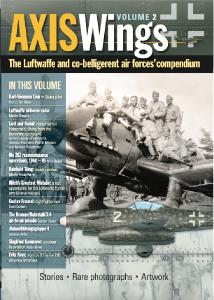
|
 |
||||||||||||||||||||||||||||||||||||||||||||||||||||||||||||||||||||||||||||||||||||||||
|
‘The Me 262’s radius of action was assessed at just 150 km’ This was the same as that quoted for the tactical reconnaissance Bf 109 G-8 after allowing for take-off, climb, time spent in the target area, encountering enemy aircraft, bad weather and landing. With a 300-litre droptank the Bf 109’s radius was extended by 100 km however. Source: Bundesarchiv RL 16-1/22: Verzeichnis der Aufstellungsvorhaben (Planungen), Stärke- und Ausrüstungsnachweisungen sowie taktisch-technische Forderungen in der Bodenorganisation (Sept. 1943–Nov. 1944) On 2 July 1944, ‘Einsatz-Kdo. Braunegg’ sent a sketch showing the general arrangement of the Me 262 reconnaissance conversion to Gen.d.A. and the Versuchsverband OKL. The covering memo has survived but not the sketch itself. Source: Bundesarchiv RL 16-1/22: Verzeichnis der Aufstellungsvorhaben (Planungen), Stärke- und Ausrüstungsnachweisungen sowie taktisch-technische Forderungen in der Bodenorganisation (Sept. 1943–Nov. 1944) As was common in pre-digital offices, the General der Aufklärungsflieger (Gen.d.A.) maintained a log of incoming and out going correspondence, summarising the contents of communications which no longer survive. Though sometimes cryptic and hard to read, a number of 1944’s entries touch on introduction of the Me 262 in the reconnaissance role. On 2 August 1944 G.d.A. was advised by the General der Kampfflieger that two Me 262s from the next delivery would be going to Kommando Braunegg. The Versuchsverband OKL sent a telegram to Gen.d.A. on 1 September about the taking over of one or more Me 262s by Einsatz Kommando Braunegg. A telegram of 26 October appeared to be asking Maj. Schultze, acting Kommandeur of NAGr. 6, whether Me 262 reconnaissance in the West could be undertaken as an adjunct to KG 51’s operations. The reply next day was in the affirmative, Kdo. Braunegg’s photographic section was ordered to ‘the operational airfield’ and more Me 262s were ordered to be readied for action. All this probably reffered Kdo. Braunegg’s subsequent deployment to Schwåbisch Hall, the base of II./KG 51’s Me 262s until late December. On 9 December it seems that G.d.A. expected to receive four more Me 262s in the coming week and the Versuchsverband was duly notified. Source: Bundesarchiv RL 16-1/53: General der Aufklärungsflieger, Brieftagebuch mit Vernichtungsvermerken (Mai 1943–-März 1945) On 29 August 1944 the Quartermaster General circulated a paper detailing how the various arms of the Luftwaffe would evolve through to December 1945 as new types entered production and stocks of older ones ran down. The Me 262 was not mentioned in the tactical reconnaissance role but under Fernaufklärungsverbände (long-range reconnaissance units) where delays in the establishment of the first Do 335 Staffel, envisaged for December 1944 ‘might possibly be offset by [using] some Me 262s as makeshift reconnaissance aircraft’. Source: Bundesarchiv RL 2-III/1123: Neuorganisation der fliegenden Verbände.- Aufstellungsmöglichkeiten, Auflösungsnotwendigkeiten.- Verbandserrechnung nach Lieferplan 226/2.- Verfügung (29. August 1944) Me 262s were first allocated to the Erprobungskommando General der Aufklärungsflieger (one aircraft on each date) on 19, 20 and 21 September 1944. NAGr. 6 was assigned an Me 110 G-4 (for twin-engined training) on 25 November, followed by two Me 262 A-2 Schul (machines limited to 800 km/h) on 28 and 30 November respectively. On 9 December it seems that G.d.A. expected to receive four more Me 262s in the coming week and the Versuchsverband OKL was notified accordingly. On the 27th an Me 262 A-1 went to ‘Kdo. Brauneck’ but NAGr. 6 would not be assigned its first Me 262 A-4s until 13 February 1945. Monthly totals of aircraft assigned were:
continued on next page …
|
|||||||||||||||||||||||||||||||||||||||||||||||||||||||||||||||||||||||||||||||||||||||||
 |
|||||||||||||||||||||||||||||||||||||||||||||||||||||||||||||||||||||||||||||||||||||||||
 |
|||||||||||||||||||||||||||||||||||||||||||||||||||||||||||||||||||||||||||||||||||||||||
